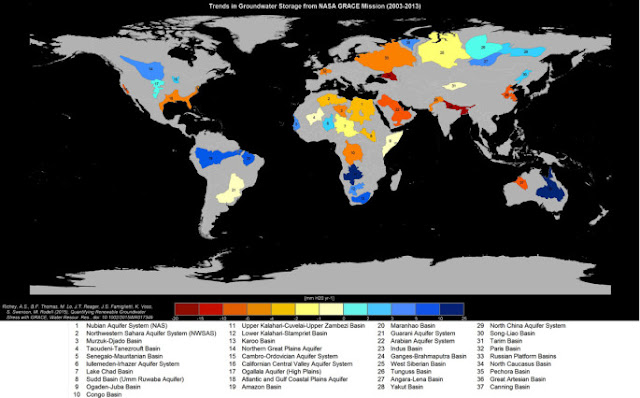Subsidence: sub·sid·ence/səbˈsīdns,ˈsəbsədns/noun:
the gradual caving in or sinking of an area of land.
"the race was abandoned because of subsidence of the track"
Similar: collapse, caving in, falling in, giving way, sinking, settling
AKA: The collapse of aquifers ... happening all over the world due to overuse of planet earth
Researchers have been warning about future water scarcity for decades, but new data reveals a majority of the world’s largest aquifers are already running out of water.
Using NASA satellite data on aquifer changes from 2003 to 2013, researchers from University of California Irvine published a study in Water Resources Research that shows 21 of the world’s 37 largest aquifers have passed the “sustainable tipping point,” meaning they are depleting faster than they recharge. Thirteen of the 21 aquifers cited fall into the “most troubled” category.
Most aquifers take thousands of years to refill, relying on snowmelt and rain to quench depleted reservoirs. But with climate change and drought pressuring parched communities, agriculture, and energy grids, reliance on groundwater is increasing, draining aquifers faster than natural systems can replenish them.
And this.
But scientists haven’t modeled global risks of subsidence—until now. To build their model, Sneed and her colleagues scoured the existing literature on land subsidence in 200 locations worldwide. They considered those geological factors (high clay content), as well as topology, as subsidence is more likely to happen on flat land. They factored in population and economic growth, data on water use, and climate variables.
The researchers found that, planet-wide, subsidence could threaten 4.6 million square miles of land in the next two decades. While that’s just 8 percent of Earth’s land, humanity tends to build big cities in coastal areas, which are prone to subsidence. So they estimate that, in the end, 1.6 billion people could be affected. The modeling further found that worldwide, subsidence exposes assets totaling a gross domestic product of $8.19 trillion, or 12 percent of global GDP.
The Ogallala Aquifer
The Ogallala Aquifer supports an astounding one-sixth of the world’s grain produce, and it has long been an essential component of American agriculture. The High Plains region—where the aquifer lies—relies on the aquifer for residential and industrial uses, but the aquifer’s water is used primarily for agricultural irrigation. The agricultural demands for Ogallala water in the region are immense, with the aquifer ultimately being responsible for thirty percent of all irrigation in the United States. The Ogallala Aquifer has long been unable to keep up with these agricultural demands, as the aquifer recharges far slower than water is withdrawn.
This is not sustainable but you already know that, right?
 The grain-growing region in the High Plains of America—known as America’s breadbasket—relies entirely on the Ogallala Aquifer. But long term unsustainable use of the aquifer is forcing states in the region to face the prospect of a regional economic disaster. As the High Plains states reach the verge of a major crisis, the states have taken different approaches to conservation with varying results.
The grain-growing region in the High Plains of America—known as America’s breadbasket—relies entirely on the Ogallala Aquifer. But long term unsustainable use of the aquifer is forcing states in the region to face the prospect of a regional economic disaster. As the High Plains states reach the verge of a major crisis, the states have taken different approaches to conservation with varying results.

No comments:
Post a Comment